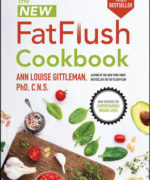According to some nutritionists and medical doctors, carbohydrates are at the root of your weight problems. This is a very logical deduction, one that can be backed up by empirical evidence. Be aware though, that for the most part, the “carbs” that are villanous are in fact the refined, packaged, processed carbohydrates—the breads, cakes, pastas, cookies, white rices and white potatoes that are prepared with a loss of nutrients, which just gets stored as extra water weight and fat tissue. Portion size is a big indicator of whether or not you will lose weight, but you might be better off just losing the refined carbs, indefinitely. See the following post for more on how to lose weight, according to Ann Louise Gittleman.
The New Fat Flush Plan. / Ann Louise Gittleman, 2017. McGraw-Hill Education. 312 pages, Notes, Resources and Index.

Ann Louise Gittleman is a nutritionist extraordinare, a diet superwoman, whose thorough understanding of the needs of weight-losers makes for interesting reading even if the reader knows less than nothing about losing weight.
Gittleman’s Fat Flush Plan is a program whereby a person follows three phases to take off the weight and keep it off via a lifestyle plan that is designed to fool-proof your eating habits. The Plan utilizes fats—flaxseed oil, coconut oil, MCT oil, avocado, gamma linolenic acid and conjugated linolenic acid—and proteins, largely from eggs, fish, meat and chicken, with an occasional tofu and tempeh to the advantage that body fat can be shed efficiently if you’re strict about restricting carbohydrates.
In short, carbohydrates get a bad rap in The New Fat Flush Plan, as in many diet plans. In Gittleman’s method for the first phase, the first two weeks of your weight loss program, you are to “cut out all grains, bread, cereal, and starchy vegetables…” p. 94. During that time, you will eat a protein at each meal for a total of 8 ounces each day, and the balance of your 1200 or so calories will be met with healthy fats, morning and afternoon snacks, and plenty of calcium and magnesium-rich vegetables.
Okay, there are a few carbohydrates to be had during the first phase and these entail jicama, daikon radish, apples, and spaghetti squash. You can sense how these vegetables and fruits have a slight natural sweetness and yet the energy of those carbohydrates is more fibrous and thus legal in the first phase.
It’s during the first phase, beginning with a three-day liquid diet, when a person loses the most weight. At that time the dieter enters a tender period where the weight could be gained back—in a snap!—if care is not taken to exclude anything from the diet that causes toxicity—such as bloating, water weight, constipation and depression. These can also cause the body to build up toxins which can later cause weight to come back.
In phases two and three, Gittleman’s choice of carbohydrates, added to the original fat and protein regimen, is limited to peas, winter squash, beets, oatmeal, quinoa, buckwheat, millet and beans, and probably for lack of space, any vegetable that is similar. Fruits are limited to berries and low-glycemic ones, for your pleasure. In phase three, a lifestyle or commitment to this way of eating is forged by means of including a more balanced choice of the three macronutrients.
Sometimes, some carbohydrates cause allergies or food sensitivities. There are a few ways to calm the system and identify the source of the problem. Basically, portion size is controlled in addition to type of food consumed. When the bad effects—toxicity, overweight conditions, sensitivities—of a carbohydrate-laden diet has been relieved by The Fat Flush Plan, the person consumes only proteins, fats, low-glycemic vegetables and fibrous vegetables. Later, the only carbohydrates allowed back into the diet are carbs that are unrefined and therefore healthy. Yet if consuming any food causes bad reactions, the dieter is cautioned to cut it out again. When the adverse reaction subsides, the suggestion is to consider adding it back in in tiny amounts, increasing them until tolerance is reached—whatever amount that may be.
As in her many books on the subjects of nutrition, weight control, toxicity, salt, sugar, parasites, energy, probiotics, and her cookbooks that supplement the Fat Flush Plan, Ann Louise Gittleman delivers a host of topics to utilize in body maintenance. In The New Fat Flush Plan, there’s a chapter on more heady stuff, entitled “The Power of Ritual” in which she shares the benefits of engaging in certain practices that enliven the diet plan. These are exercise, journaling, therapeutic bathing, and the quality of your sleep.
A good third of the book is devoted to extras that contribute to the overall quality of your experience on this plan. Recipes, resources, and a chapter called “The Fat Flush Plan Away from Home” round out the experience and offer to make it more complete than your average diet plan. The reader really gets the sense that Gittleman has lived this plan herself by the choices she exposes for various ethnic restaurants, which fast foods are likely to contain forbidden ingredients like trans fats, and how to defend yourself against an onslaught of temptation at parties, at home, on holidays, and in the office.
See her website at AnnLouise.
For an alternative view, see this article from Authority Nutrition.
Follow


